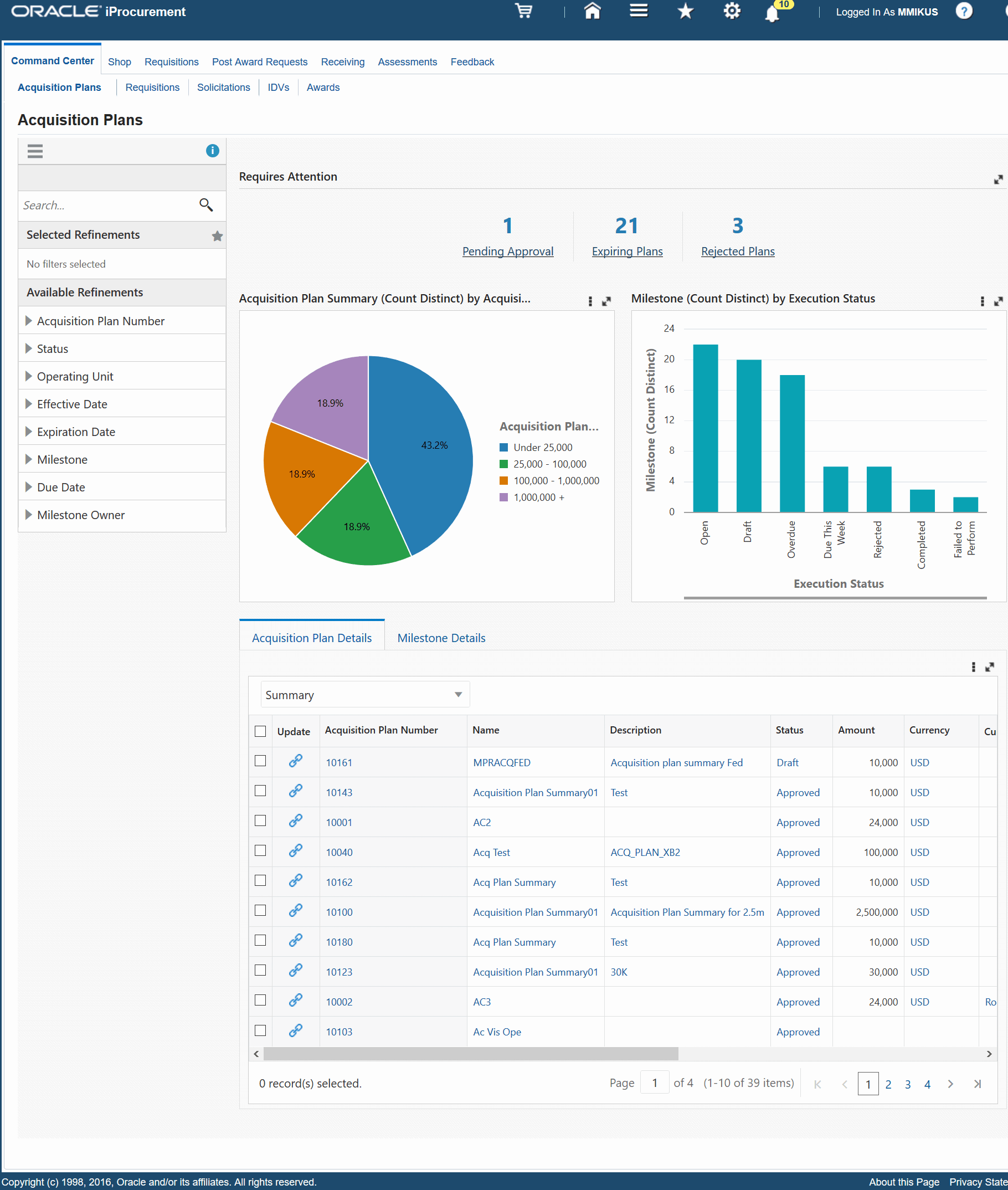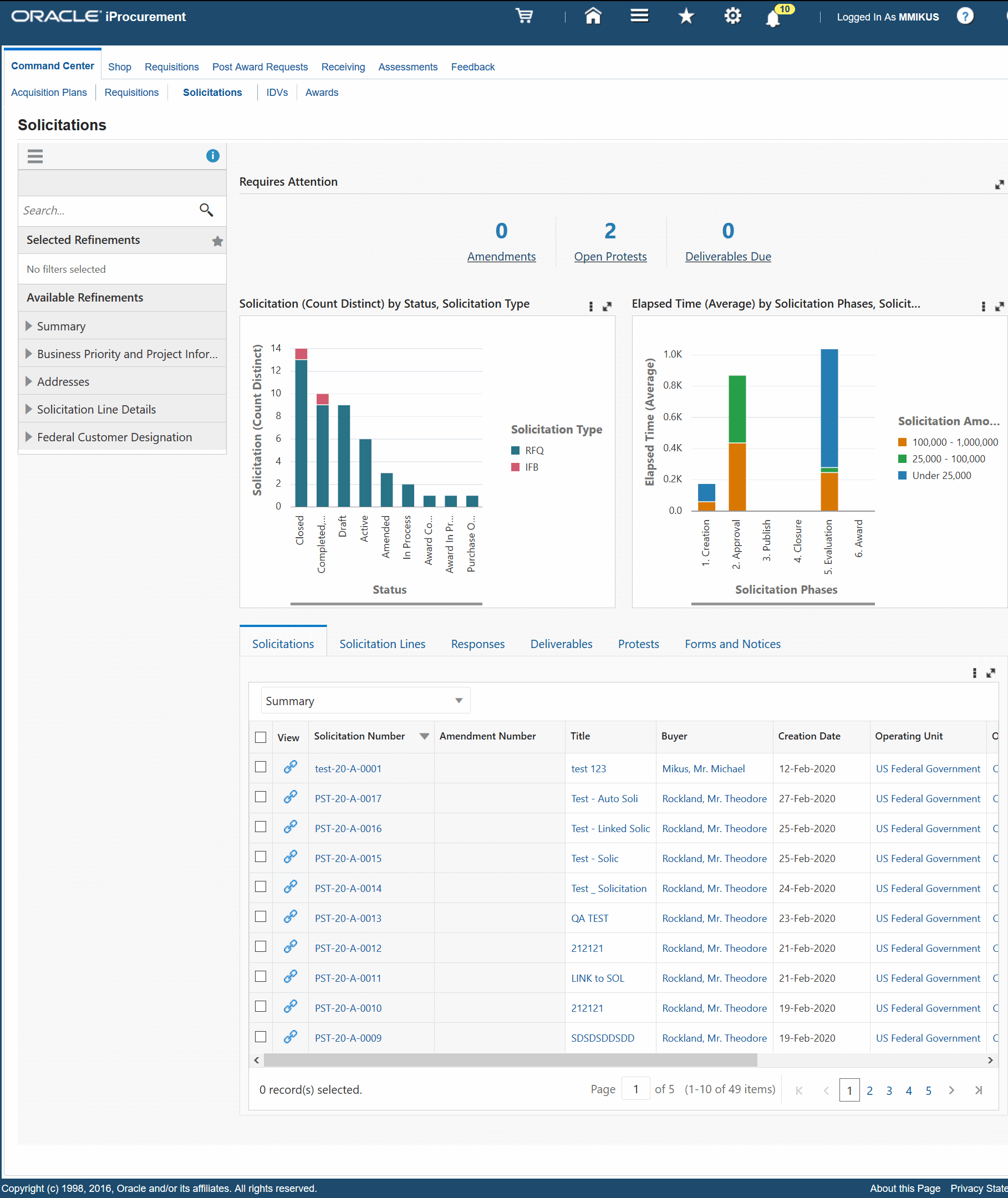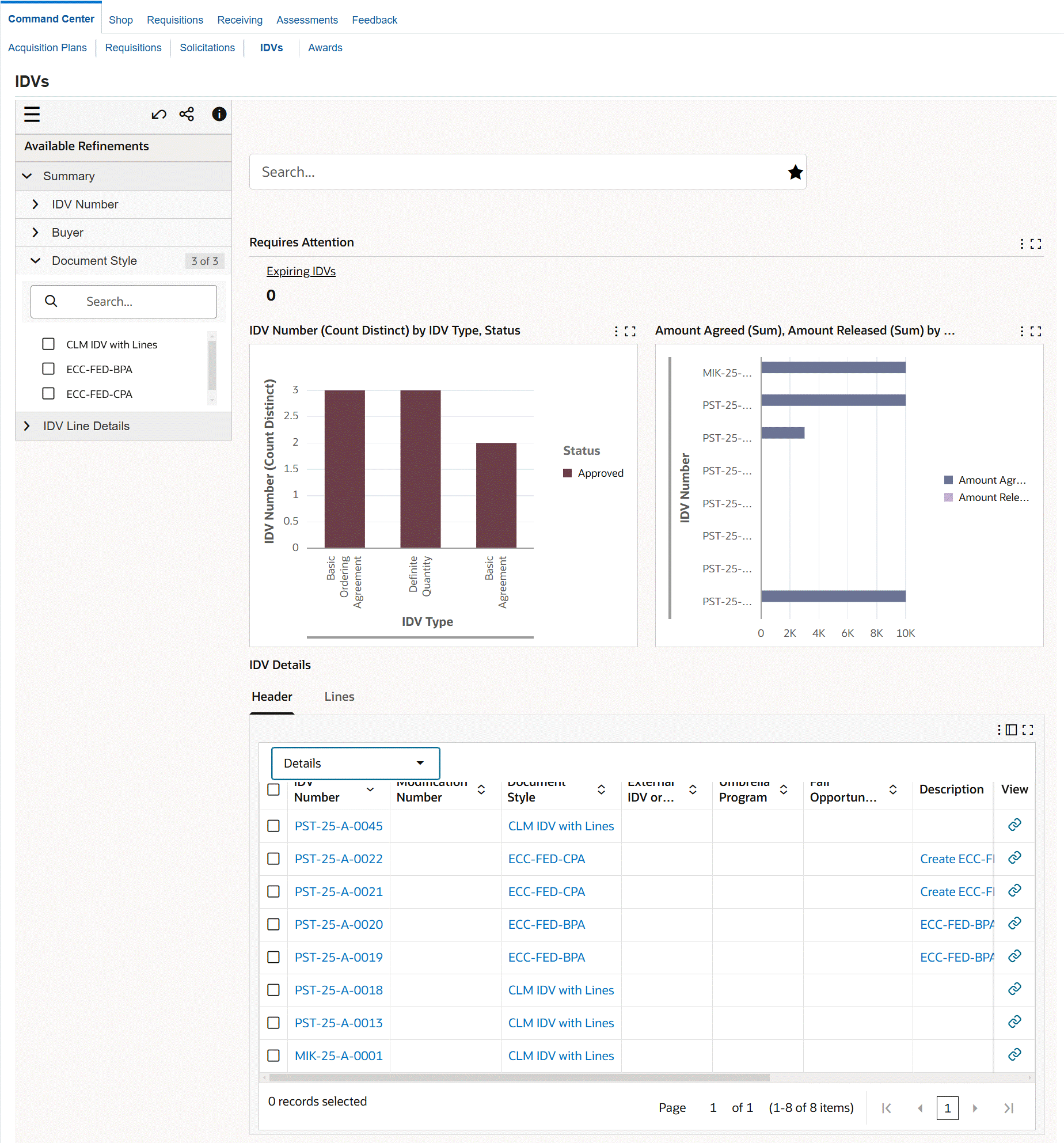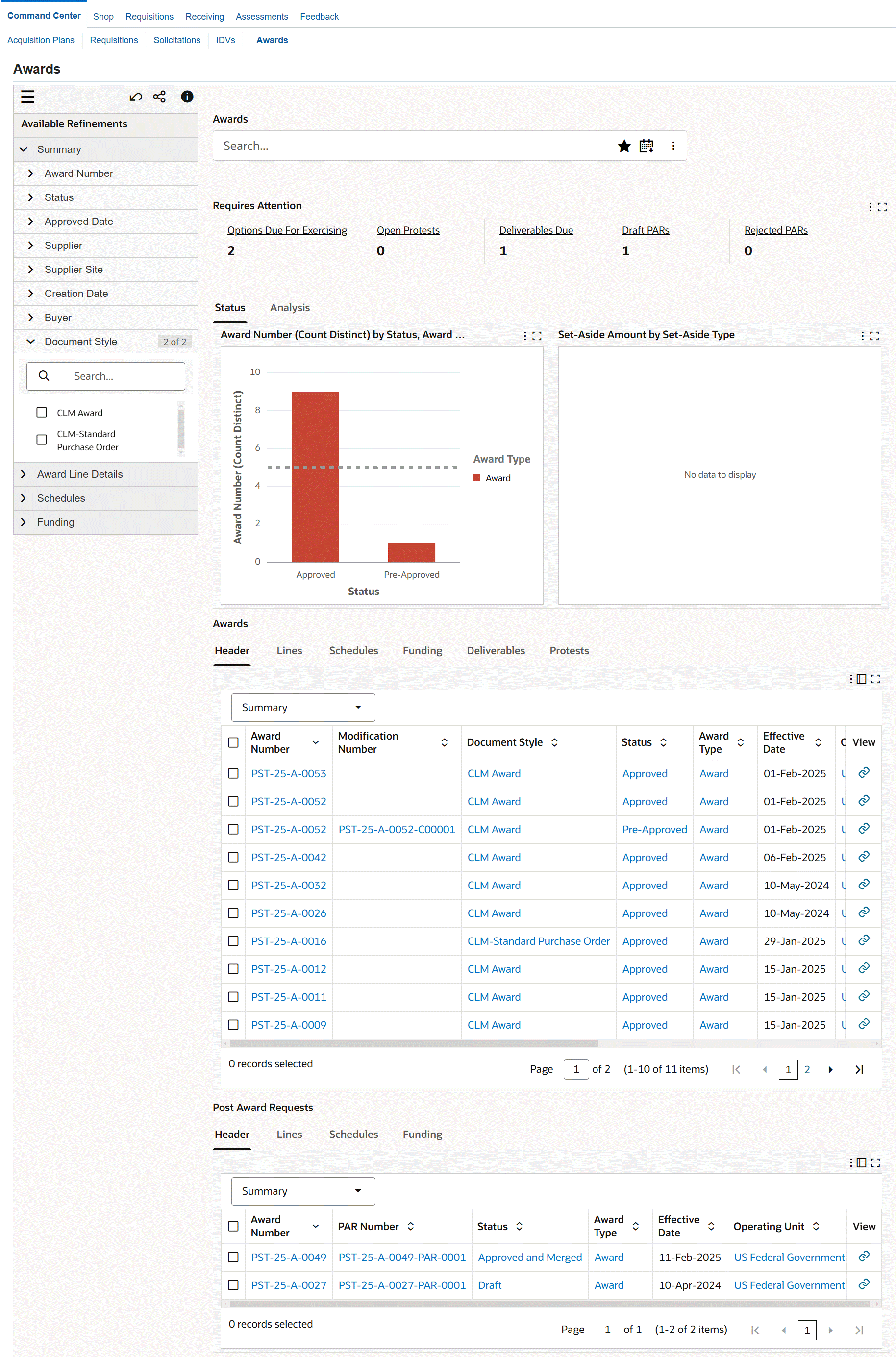Oracle Contract Lifecycle Management for Public Sector Command Center
This chapter covers the following topics:
- Contract Lifecycle Management (CLM) for Public Sector Command Center Overview
- Overview of Dashboards for Program Management Office (PMO) Managers
- PMO Acquisition Plans Dashboard
- PMO Requisitions Dashboard
- PMO Solicitations Dashboard
- PMO IDVs Dashboard
- PMO Awards Dashboard
Contract Lifecycle Management (CLM) for Public Sector Command Center
Contract Lifecycle Management (CLM) for Public Sector Command Center Overview
The Oracle Contract Lifecycle Management (CLM) for Public Sector Command Center presents contracting officers, contracting specialists, program managers, and members of the legal team with information from all procurement processes in the enterprise. Use this data to maximize productivity for a variety of end-to-end business processes.
The command center enables procurements teams to collaborate, review, analyze, and act to:
-
Maintain information symmetry.
-
Provide consistent document visibility to program office and procurement teams across projects.
-
Ensure that contract insights are available to all stakeholders.
-
-
Improve procurement cycle-time management.
-
Identify critical activities that require attention by comparing planned versus actual durations.
-
-
Maintain IAE: Integrated Award Environment (IAE) and Small Business Coordination Record (SBCR) compliance.
-
Better contract compliance through proactive alerts.
-
Increase Contract Action Report (CAR) compliance.
-
Meet socioeconomic distribution requirements for contract compliance mandates.
-
The CLM Command Center includes role-based dashboards with metrics and charts that highlight critical information around the day-to-day activities of contracting officers, specialists, and project managers. The command center provides in-depth, multidimensional analysis using transactional data so that you can take corrective actions to resolve issues proactively. You can drill down directly from the dashboards to the CLM application pages for immediate access to the underlying processes.
CLM Command Center Dashboards for Roles
The CLM Command Center provides dashboards for two primary roles:
-
Contracting Officer (CO)
-
Program Management Office (PMO) Manager
These dashboards are organized by role under the following responsibilities and menus:
-
Dashboards for Program Management Office (PMO) Managers: The following dashboards are available under the Command Center menu in the CLM iProcurement responsibility.
-
Acquisition Plans
-
Requisitions
-
Solicitations
-
IDVs
-
Awards
See Overview of Dashboards for Program Management Office (PMO) Managers.
-
-
Dashboards for Contracting Officers: The following dashboards are available under the Command Center menu in the CLM Purchasing Super User responsibility.
-
Requisitions
-
Solicitations
-
IDVs
-
Awards
See Overview of Dashboards for Contracting Officers, Oracle Contract Lifecycle Management for Public Sector Purchasing User Guide.
-
Important: Though the same dashboards (Requisitions, Solicitation, IDVs, and Awards) are available to PMO managers and contracting officers, these dashboards display metrics, refinements, charts, tag clouds, results tables, and actions specific to the target roles.
Note: You can use the CLM Command Center only after the installation and common configurations are completed as described in My Oracle Support Knowledge Document 2495053.1, Installing Oracle Enterprise Command Center Framework, Release 12.2. For additional ECC overview information, see Overview of Enterprise Command Centers, Oracle E-Business Suite User's Guide.
Searching Enterprise Command Center Dashboards
Use the dashboard sidebar to refine (filter) the data on each dashboard. You can select a value or record from the Available Refinements component, or use Search to find a keyword, a value, or a specific record. The type-ahead feature suggests matches for your entry that correspond to the available refinements. When you submit a search, the search term is added to the Selected Refinements list, and the dashboard data is refined to include only records that match the search. You can add multiple refinements and remove any of them at any time. Use Saved Search to create and save your search. You can edit, delete, or refer to this saved search. You can also use data sets to further refine your search.
Use an asterisk (*) or percent (%) to perform a partial keyword or record search that matches any string of zero or more characters. You can also use a question mark (?) to perform a partial search that matches any single character.
Additional Information: For more information about searching for and refining data in enterprise command centers, see Search in Highlights of an Enterprise Command Center, Oracle E-Business Suite User's Guide.
User Defined Attribute Search
In addition to the predefined search attributes displayed in the Available Refinements component, the CLM Command Center dashboards display the following attributes, if relevant data exists for these attributes.
| Attribute | Description |
|---|---|
| POP Start Date Within | Search for requisitions for which the need-by date or the period of performance (POP) start date is the value defined in the date range. As a date range, you can provide a value such as 0 to 30 days or 0 to 60 days. |
| Submitted Before Need-By Date | The approved date of a requisition line is less than or equal to the value defined in the date range from the need-by date or the period of performance start date. Use this attribute to search for requisitions that are submitted and the need-by date or the period of performance start date falls in the specified date range. As a date range, you can provide value such as 0 to 30 days or 0 to 60 days. |
| Options Exercised On Time | If the option is exercised on time then it is YES. If the option is not exercised or exercised not within time, then the value is NO. |
| Elapsed Days | This is the number of days that are remaining to start working on assignment. This attribute is calculated as: system date minus (-) start date for assignment. |
| Funded On Time | Award or IDV lines that are fully funded before the need-by date or the period of performance start date. |
| Planned Duration in Days | The total duration in days for an acquisition plan. This attribute is calculated as: expiration date minus (-) effective date. |
| Elapsed Duration in Days | The number of days from which the acquisition plan is effective. This attribute is calculated as: system date minus (-) start date for acquisition plan. |
| Liquidatable | This attribute is available on the Requisitions dashboard if there are partially funded requisition lines. The Details option in the Requisition Lines results table displays the following columns:
|
Dashboards for Program Management Office (PMO) Managers
Overview of Dashboards for Program Management Office (PMO) Managers
See Contract Lifecycle Management (CLM) for Public Sector Command Center Overview for information about the CLM Command Center.
As a PMO manager, use the dashboards to work with the following procurement documents:
Navigate to the dashboards using the CLM iProcurement responsibility.
PMO Acquisition Plans Dashboard
For information about dashboards for PMO managers, see Overview of Dashboards for Program Management Office (PMO) Managers.
Use the Acquisition Plans dashboard to:
-
Track the progress of procurement requirements in a timely and cost-effective manner.
-
Identify plans waiting for approval.
-
Follow up on expiring plans.
-
Analyze reasons for plan rejection.
-
-
Gain insight into the number of acquisition plans per plan amount.
-
Monitor the performance of milestones.
-
Review the status of milestones in acquisition plans.
-
Measure the time taken for completion of milestones by gathering details about milestone duration.
-
-
Update acquisition plans.
Access the Acquisition Plans dashboard using the following navigation.
CLM iProcurement responsibility > Command Center > Acquisition Plans
Acquisition Plans Dashboard

The following table describes the dashboard:
| Component | Description |
|---|---|
| Requires Attention (summary bar) | This summary bar displays the following metrics.
|
| Acquisition Plan Summary (Count) by Acquisition Plan Amount (chart) | The chart shows the number of plans in each range of amounts, and the amount distribution by percentage. The hover text for each segment on the chart displays the number of acquisition plans in a specific amount range. |
| Milestone (Count) by Execution Status (chart) | This bar chart displays the number of milestones for various execution statuses. |
| Acquisition Plan Details and Milestone Details (results tables) | These tables display acquisition plan summaries and milestone details. Use attribute groups in the results tables to see more information about acquisition plans. To edit the details for an acquisition plan or a milestone, click the link icon in the Update column. |
| Options (table-level actions) | The following are the common actions that are available from the Options icon in the results tables.
|
PMO Requisitions Dashboard
For information about dashboards for PMO managers, see Overview of Dashboards for Program Management Office (PMO) Managers.
The Requisitions dashboard provides end-to-end visibility into requisitions management. From this dashboard, you can review, monitor, and analyze requisitions.
Use the Requisitions dashboard to:
-
Prioritize work and discover and resolve problems in requisition management.
-
Review requisition authorization status.
-
Analyze reasons for requisition rejection.
-
Track the status of Military Interdepartmental Purchase Requests (MIPRs).
-
Monitor contract lines (CLINs) and sublines (SLINs).
-
-
Take action to decrease requisition backlog.
-
Monitor pending requisition tasks.
-
Review requisitions that are pending approval and follow up with approvers.
-
Identify and follow up on options that are due for exercising.
-
-
Analyze the fund status of requisition lines.
-
View the percentages of requisition lines that are fully, partially, and not funded.
-
View the reserved and funded value for requisition lines.
-
-
Evaluate project budget details using information such as project obligated funds, task obligated and unobligated funds, and the remaining budget.
-
Assess business priority and project information using details such as the Defense Priorities and Allocations System Rating (DPAS) and the customer project code.
Access the Requisitions dashboard using the following navigation:
CLM iProcurement responsibility > Command Center > Requisitions
Requisitions Dashboard

The following table describes the dashboard:
| Component | Description |
|---|---|
| Requires Attention (summary bar) | This summary bar displays the following metrics.
|
| Status (tab) | This tab shows the following charts:
|
| Analysis (tab) | This tab shows the following charts:
|
| Requisitions, Requisition Lines, Funding, and Budget Details (results tables) | These tables display requisitions summaries and details for requisition lines, funding, and budget. Use attribute groups in the results tables to see more information about requisitions. To view details for requisitions, requisition lines, and funding, click the link icon in the View column. |
| Options (table-level actions) | See Performing Actions for information about the available actions that you can perform by selecting the Options icon in the results tables. |
Performing Actions
The following sections describe the actions that you can perform from the Options icon in the results tables.
Common Actions
The following are the common actions that are available from the Options icon in the results tables.
-
Compare: Select multiple rows to compare information.
-
Export: Use this action to export the search results in a comma-separated values (CSV) file.
Actions for Requisitions

Actions for Requisition Lines

The following table describes the actions available when you select the Options icon in the results tables. Select one or more rows and click the Options icon to act on your selection.
| Action | Results Table | Action Description |
|---|---|---|
| Liquidate | Requisitions, Requisition Lines | Use this action to unreserve funds from requisitions and requisition lines. If there are funds remaining in a requisition, and they will not be used to fund other awards, then the remaining funds can be liquidated. Liquidation unreserves funds from requisitions only, and this action does not affect the line amounts and distributions. Note: If a requisition is partially awarded and the amendment on the requisition is in process, then you cannot liquidate this requisition. You can unreserve funds from the following requisitions:
To view requisitions that are partially utilized for awards, in Available Refinements, select Liquidatable and date range options. In the Requisitions Lines table, select the Details option and review the Liquidatable column, which shows whether requisition lines are allowed for liquidation. The Funds Liquidatable column displays the funds that are available for liquidation. To unreserve funds:
|
| Cancel | Requisitions, Requisition Lines | Use this action to cancel multiple requisitions as part of the period end process to relieve funds from commitments. You can cancel the following requisitions:
To cancel requisition lines, use the Requisitions in pool and date range filters from Available Refinements and review the requisition lines. When you select lines and click Cancel, a Review page appears with lines' details. Review the status of lines, enter a reason for cancellation, and click Submit. Cancelling Project Related Requisitions Note: To cancel project related requisitions, you must have access to Oracle Projects Command Center. To cancel requisition lines of a project:
|
PMO Solicitations Dashboard
For information about dashboards for PMO managers, see Overview of Dashboards for Program Management Office (PMO) Managers.
Use the Solicitations dashboard to track and analyze the solicitation process.
You can:
-
Speed up the procurement process by monitoring the progress of solicitations.
-
Track draft solicitation amendments that are waiting for approval.
-
Review open protests and take action to resolve them.
-
Follow up on solicitation deliverables that are due or overdue.
-
-
Quickly see the total number of solicitations per solicitation type and view their statuses.
-
Review the time taken by each solicitation in a solicitation phase.
-
Review responses to solicitations.
Access the Solicitations dashboard using the following navigation.
CLM iProcurement responsibility > Command Center > Solicitations
Solicitations Dashboard

The following table describes the dashboard:
| Component | Description |
|---|---|
| Requires Attention (summary bar) | This summary bar displays the following metrics.
|
| Solicitation (Count) by Status, Solicitation Type (chart) | By default, this bar chart shows the number and the status of solicitations for each solicitation type. Select a different dimension to view the number and the status of solicitations by solicitation number, sourcing project, category, or acquisition plan. |
| Elapsed Time (Average) by Solicitation Phases, Solicitation Amount Range (chart) | This bar chart shows the average time it takes to process solicitations through phases and by amount ranges. |
| Solicitations, Solicitation Lines, Responses, Deliverables, Protests, and Forms and Notices (results tables) | These tables display solicitations summaries and details for solicitation lines, responses, deliverables, protests, and forms and notices. Use attribute groups in the results tables to see more information about solicitations. To view details, click the link icon in the View column in these results tables. |
| Options (table-level actions) | The following are the common actions that are available from the Options icon in the results tables.
|
PMO IDVs Dashboard
For information about dashboards for PMO managers, see Overview of Dashboards for Program Management Office (PMO) Managers.
Use the IDVs dashboard to:
-
Search for IDVs using the document style.
-
Use the Document Style attribute from Available Refinements for search.
-
-
Identify IDVs that must be completed.
-
Monitor the status of IDVs.
-
Compare the amount agreed to with the amount released for IDVs.
-
Review header-level and line-level IDV details.
-
Review the ordering constraints for IDVs.
-
Analyze the business priority and set-aside information such as the set-aside status, the set-aside type, and the set-aside percentage.
-
Match new requirements to existing IDVs using the Federal Supply Classification (FSC) or the item description.
Access the IDVs dashboard using the following navigation.
CLM iProcurement responsibility > Command Center > IDVs
IDVs Dashboard

Note: You can view only IDVs that are approved.
The following table describes the dashboard:
| Component | Description |
|---|---|
| Requires Attention (summary bar) | The Expiring IDVs metric shows the number of IDVs that will expire within the next 30 days. |
| IDV Number (Count) by IDV Type, Status (chart) | This bar chart shows the number and the status of IDVs for each IDV type. |
| Amount Agreed (Sum), Amount Released (Sum) by IDV Number (chart) | This dual metric bar chart shows the sum of the amount agreed to and the sum of the amount released, that is, the amount consumed for an IDV. |
| IDV Details (tabbed component) Header and Lines (results tables) |
These tables show details for IDV headers and lines. Use attribute groups in the results tables to see more information about IDVs. If you select the Document Style refinement to search for IDVs, then the Header results table displays the document styles associated with the IDVs. To view details for a header or a line, click the link icon in the View column. |
| Options (table-level actions) | The following are the common actions that are available from the Options icon in the results tables.
|
PMO Awards Dashboard
For information about dashboards for PMO managers, see Overview of Dashboards for Program Management Office (PMO) Managers.
Use the Awards dashboard to:
-
Search for awards using the document style.
-
Use the Document Style attribute from Available Refinements for search.
-
-
Track and monitor award-related tasks and take corrective on open protests, deliverables due, and draft and rejected post-award requests.
-
Assess awards and their statuses to follow up and complete them.
-
Review the award header and lines summary and details.
-
Review the budget distribution amount set for specific disadvantaged businesses for compliance.
-
Compare awarded, funded, billed, received, and paid amounts.
Access the Awards dashboard using the following navigation.
CLM iProcurement responsibility > Command Center > Awards
Awards Dashboard

Note: To view awards, the following rules apply:
-
The awards must be approved with backing requisitions.
-
You must have access to the backing requisitions.
The following table describes the dashboard:
| Component | Description |
|---|---|
| Requires Attention (summary bar) | This summary bar displays the following metrics:
|
| Status (tab) | This tab contains the following charts.
|
| Analysis (tab) | This tab contains the following charts.
|
| Awards (tabbed component) Header, Lines, Schedules, Funding, Deliverables, and Protests (results tables) |
These tables display details for headers, lines, schedules, funding, deliverables, and protests. If you select the Document Style refinement to search for awards, then the Header results table displays the document styles associated with the awards. To view details, click the link icon in the View column in these results tables. |
| Post Award Requests (tabbed component) Header, Lines, Schedules, and Funding (results tables) |
These tables display details for headers, lines, schedules, and funding. Use attribute groups in the results tables to see more information about awards. To view details, click the link icon in the View column in these results tables. |
| Options (table-level actions) | The following are the common actions that are available from the Options icon in the results tables.
|